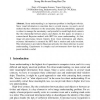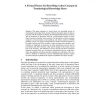278 search results - page 2 / 56 » Describing Visual Scenes Using Transformed Objects and Parts |
SPATIALCOGNITION
2000
Springer
13 years 9 months ago
2000
Springer
We present an approach to spatial inference which is based on the procedural semantics of spatial relations. In contrast to qualitative reasoning, we do not use discrete symbolic m...
ACIVS
2006
Springer
13 years 10 months ago
2006
Springer
Scene understanding is an important problem in intelligent robotics. Since visual information is uncertain due to several reasons, we need a novel method that has robustness to the...
AI
2003
Springer
13 years 11 months ago
2003
Springer
This paper introduces a formal theory for describing actions in terminological knowledge bases, closely related to description logics. It deals in particular with the problem of ad...
3DPVT
2006
IEEE
14 years 6 days ago
2006
IEEE
We propose a mathematical approach for quantifying shape complexity of 3D surfaces based on perceptual principles of visual saliency. Our curvature variation measure (CVM), as a 3...
CVPR
2007
IEEE
14 years 8 months ago
2007
IEEE
This paper presents a method of learning and recognizing generic object categories using part-based spatial models. The models are multiscale, with a scene component that specifie...


